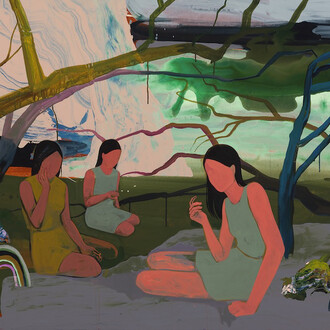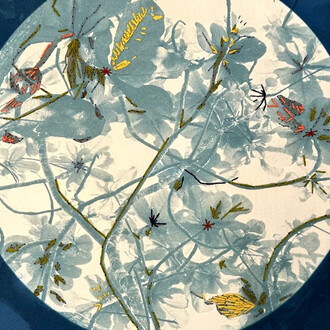Fantastical landscapes are depicted moving, shifting, and glowing. Tangled spaces that are seemingly untraversable bloom and glisten with vibrancy and energy. Using a saturated palette, the artist creates landscapes from imagery found in overgrown areas of the South, primarily in Alabama where the artist lives.
Imagery of kudzu and vines form visually dense compositions. The image spaces are tight fields of color and shapes, tapestries of marks, that form environments the artist refers to as “Fields”. The repetitive frames of the paintings—rectangles and squares— serve as a type of sequencing, informed by the artist’s interest in meditative and yogic practices that are used to access the subconscious mind and make subtle changes in the body. Memories and dreams become accessible through meditation, where phrases are repeated as a way to turn off the automatic mind and make subtle shifts in the subconscious landscape.
Liza Butts Field of rushes frigures are absent in the works. Wilderness spaces of solitude and reflection reveal subtle shifts that show themselves in patterned mark-making. The artist explores ancient myths and symbols of marshlands with titles like Field of rushes, coming from an Egyptian myth of afterlife that speaks to transition and change. Marshlands serve as a metaphor for liminal in between places, hidden states of becoming, rich in growth and plant-life. Kudzu plants with their long overgrown vines that grow rapidly over terrains, hide abstract forms underneath.
Some paintings appear to be underwater, with expressive and fluid gestures. The artist uses oil paint diluted with mediums, applied over many layers. Mark-making reveals a history and a progression, with small movements coming in and out of focus. The paint’s fluid materiality points to liminal unfixed spaces where things change, move, and adapt quickly.
The artist grapples with personal and collective pressures where tensions are held both internally and externally in the landscape, situated within a political environment that is pulled between two poles; opposite ends of a spectrum. The work also deals with the early part of an artist’s career where pressures exist that the artist must reconcile with. The work attempts to hold these tensions to allow for something to rupture and emerge so transformation can take place.












